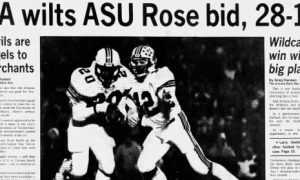[rps-paypal]
The best Arizona football coach in the history of the program is …
Gerald Allen “Tex” Oliver?
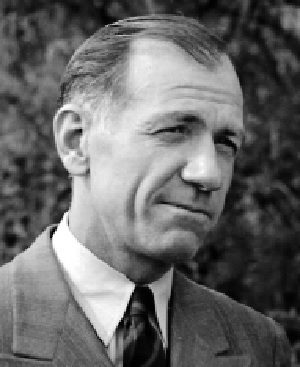
G.A. “Tex” Oliver is one of Arizona’s most successful coaches yet you may have never heard of him
In terms of a five-year span — the length of Oliver’s career at Arizona from 1933 to 1937 — yes, no other coach can touch Oliver’s 32-11-4 record. His winning percentage of 72.3 tops all other Wildcat coaches.
Larry Smith has the highest winning percentage in the modern era (in the last 50 years) of coaches with at least a five-year span at 62.7 with a record of 48-28-3 from 1980 to 1986.
Dick Tomey, who was 95-64-4 from 1987 to 2000, has the most victories as an Arizona coach. He is widely regarded as the Wildcats’ best coach because of his longevity (14 years) and his introduction of the Desert Swarm in 1992 and 1993 and the 12-1 team of 1998.
Just imagine, however, what Oliver could have brought Arizona’s program if the school’s administration and Towncats — a booster group at the time — succeeded in keeping him as coach following a 1937 season in which the Wildcats finished 8-2 after winning their last six games. In 1935 and 1936, Oliver’s boys earned consecutive Border Intercollegiate Athletic Association titles, the only time Arizona has achieved outright conference championships in its history.
Instead of being cursed — or so it seems — over the last 80 years without an outright conference title since Oliver’s departure, perhaps Arizona could have gained momentum with him in charge and established itself as a Western college football power with many more unchallenged championships? We’ll never know.
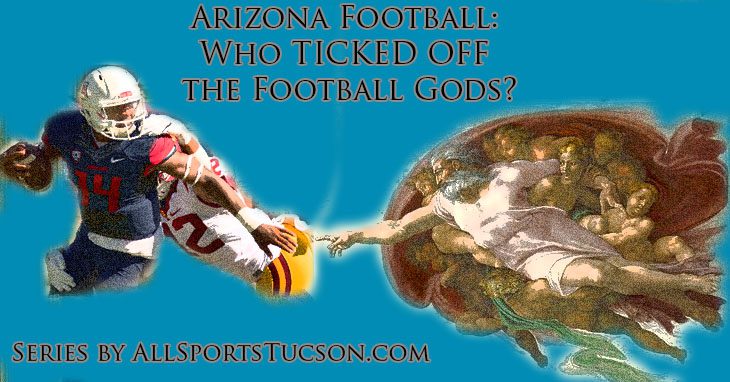
PREVIOUSLY IN THE SERIES:
— If Cubs have Curse of the Billy Goat, what superstition has subdued Arizona football for 80 years?
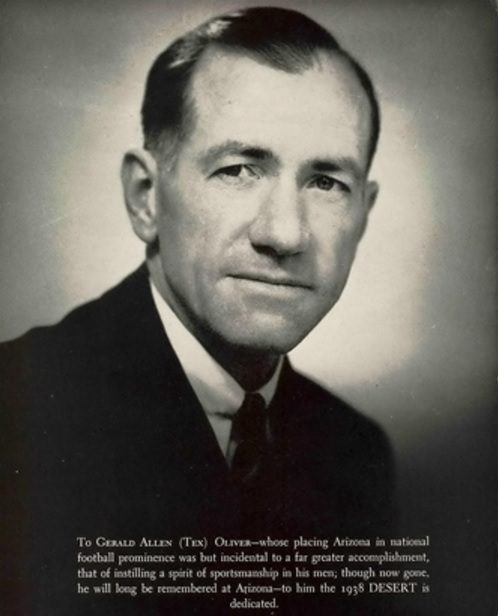
Arizona’s Desert Yearbook in 1937-38 was dedicated to Tex Oliver
A brief bio on Oliver, who ironically is unknown to most Arizona football followers despite being one of the most successful to coach there:
Oliver, who passed away from cancer in 1988 at 88 years old, was a World War I veteran who was born in Georgia but spent most of his adolescent life near Houston. His Southern drawl and Texas background originated the “Tex” nickname. After attending West Point for two years, he first worked as a land appraiser for the Santa Fe Railroad Co. (which introduced him to the Tucson area) before he joined the Southern California Telephone Co. While working there, he took postgraduate studies at USC
He graduated in 1923 from USC, where he learned about coaching football from Gus Henderson, who compiled a 45-7 record from 1919 to 1924 with the Trojans.
Oliver’s first coaching experience — in football and track and field — came about at a San Diego junior high school in 1924 before he advanced to Santa Ana (Calif.) High School in 1926. In 1931, Santa Ana won the Southern Section Major Division football championship. The next year, Santa Ana lost to Inglewood in the title game.
A TRACK COACH AT FIRST
Arizona’s track program actually lured Oliver to Tucson in 1933. The Wildcats were in need of a coach and J.F. “Pop” McKale, the athletic director, did not hesitate to hire the 33-year-old coach. Three months after Oliver arrived in Tucson, Arizona’s football team needed a head coach because A.W. Farwick, an Army lieutenant, had to transfer to another locality for military reasons.
Arizona went from McKale as football coach in 1930 to Fred Enke Sr. (a temporary fill-in because he was more of a basketball coach) in 1931 to Farwick in 1932 before Oliver took over the program in 1933. Oliver introduced a forward passing scheme — revolutionary in those days– to Arizona called the “Oliver Twist”, which included a shifting backfield that tried to fool defenses similar to the play-action pass these days.
The Wildcats were 7-10-1 in the two years before Oliver’s hire. He did not endure a losing season in his five years with Arizona going 5-3 in 1933, 7-2-1 in 1934, 7-2 in 1935, 5-2-3 in 1936 and 8-2 in 1937. Oliver was 5-0 against ASU, then named the Tempe Bulldogs, outscoring the rival school 122-19. The Wildcats developed during this time the nickname “The Blue Brigade”, which rivals “Desert Swarm” for the program’s best nickname in history because of its tough image.
With such a successful tenure how could Arizona let Oliver get away?
OLIVER OR-E-GONE
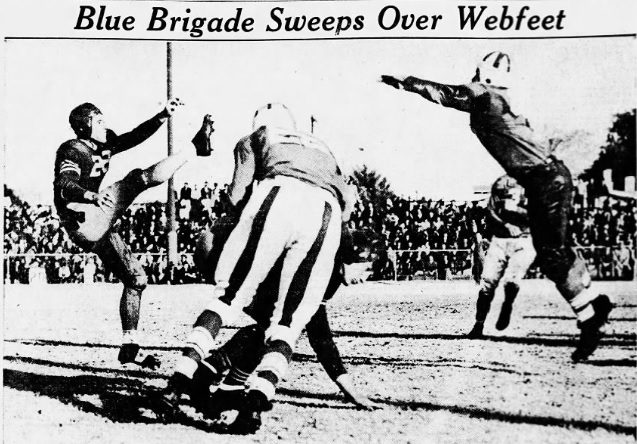
1937 clipping from Arizona Republic shows the Wildcats’ George Wendell Rogers attempting to block a punt in what would be Tex Oliver’s last game as the Wildcats’ head coach, a 20-6 win over Oregon in Tucson.
The last team Oliver beat as Arizona’s coach was Oregon in Tucson by a score of 20-6 on Dec. 4, 1937. The “Web Foots”, as they were called at the time, played in the Pacific Coast Conference, a significant step up in competition for Arizona from the Border Conference.
“The team that beat Stanford, Washington State and Gonzaga, left the university’s brown sod this afternoon a badly whipped 11,” the Arizona Republic reported. “Oregon is a member of the Pacific Coast Conference, and that’s the type of competition that coach Tex Oliver’s Blue Brigade has never faced.”
Less than two months later, Oregon robbed Oliver from Arizona to fill its coaching vacancy after former coach Prince Callison resigned under pressure. The Wildcats failed to match Oregon’s contract terms for Oliver, allowing its potential version of Knute Rockne to skip town.
Oliver accepted Oregon’s three-year contract offer for $6,500 a year. The Arizona Republic described the reasons for Oliver leaving as follows …
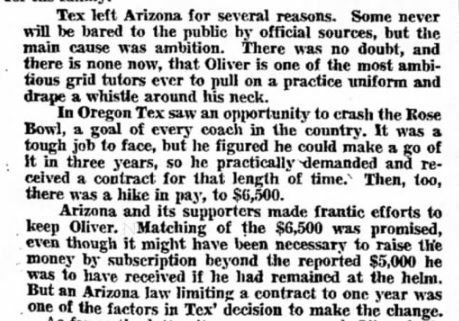
Worth noting: Larry Smith left Arizona for conference rival USC in 1986 because the Arizona Board of Regents did not yet change its provision of one-year contracts.
Allowing its best coaches to leave without much of a fight? Arizona asked for this curse, if it is one.
“If Tex goes to Oregon it will be Arizona’s loss and Oregon’s gain,” lamented McKale in an Arizona Republic report Feb. 1, 1938, the day it was announced Oliver was bound for Eugene, Ore.
OLIVER’S RETURN?
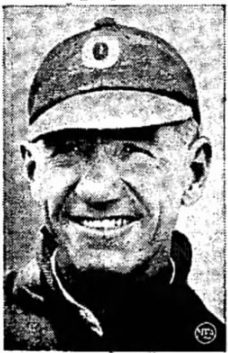
Tex Oliver as Oregon’s coach in 1938
In the season after Oliver’s exit, Arizona deteriorated to a 3-6 record under young Orian M. (Toad) Landreth, whose resume was similar to Oliver’s before he came to Tucson. Landreth was a 33-year-old promising coach from the California high school league, coaching Long Beach Poly to success. The demands of coaching the Wildcats reportedly took a toll on Landreth’s health.
The thought of taking on the difficult schedule developed by Oliver was enough to scare Landreth away. The Wildcats played powerhouse SMU in 1938 and Oliver had scheduled games at Minnesota in 1939 and Notre Dame in 1941. Not only did Arizona lose Oliver’s coaching ability, it lost his foresight to make Arizona a viable program.
Landreth immediately fled back to Long Beach Poly to coach there after only a year in Tucson. The Wildcats were in desperate need of a quality coach to lead them after the instability brought upon by Landreth’s abrupt departure. The first candidate mentioned: Tex Oliver.
McKale reportedly phoned Oliver to gauge his potential interest of returning to Tucson. Multiple reports suggested McKale offered Oliver a $7,000 annual salary and control over all football matters at the university, including the freshman team, and the scheduling of games. McKale could not offer a multi-year deal, because of the board of regents’ one-year contract rule, but he tried to assure Oliver that he could remain as coach for as long as he wants.
Reports indicated that Oliver asked McKale for another year to decide with the likelihood of returning to Arizona in 1940.
An informant told the Arizona Republic that several members of Arizona’s board of regents “expressed opposition to offering (Oliver) the job again because of his taking the Oregon post when Arizona’s immediate football future to a certain extent was at stake, particularly in view of the fact that many of the big games booked were at Oliver’s direction.”
Some board members also accused Oliver of using a possible return to Arizona as leverage for a better deal with Oregon.
That was that. The flames from this charge burned any chance of Oliver’s return.
FORGOTTEN MAN

Class of 1950 Fullerton Junior College Yearbook shows Tex Oliver as a golf and tennis coach, the same school year he left Tucson after spending time as a real estate agent
Arizona hired Michigan State assistant coach Miles Casteel instead for a reported $6,000 salary. A gentleman’s agreement was made for a three-year deal. Casteel would coach eight seasons at Arizona from 1939 to 1942 and 1945 to 1948 — Arizona did not field a team in 1943 and 1944 because of World War II.
Casteel accumulated a record of 45-26-3 in his respectable tenure at Arizona, which came to a close with a berth in the 1948 Salad Bowl against Drake. The board of regents opted to dismiss Casteel after the coach became involved in a power struggle with Arizona’s administration over his lack of plays involving the popular T-formation offense.
Oliver’s name once again surfaced as a candidate. But by then, Oliver was out of coaching after an unsuccessful six years at Oregon (23-28-3 record there). During his tenure at Oregon, he was commissioned as a lieutenant in the Navy during World War II and coached the St. Mary’s Preflight team there.
When Casteel was fired by Arizona in 1949, Oliver was in the real estate business in Tucson.
“I am through with coaching for good,” Oliver told the Arizona Republic. “I suppose you might put it this way: If someone left me a million dollars I would return to football. This isn’t going to happen. I’ve devoted most of my life to football. It is time I thought of something else.”
That same school year, 1949-50, Oliver in fact returned to coaching — at Fullerton (Calif.) Junior College — as a golf and tennis coach. He was talked into coaching Fullerton’s football program in 1950. His coaching career unceremoniously ended for good the following season in 1951. He became superintendent of schools in Lancaster (Calif.) until his retirement in 1966.
Tex Oliver became a forgotten man in Tucson by that time, almost 30 years after coaching Arizona into prominence.
His potential legacy in Tucson never became realized, much like Arizona’s promise as a program worthy of numerous outright conference titles.
Next in the series: What went wrong with Warren Woodson
FOLLOW @JAVIERJMORALES ON TWITTER!
ALLSPORTSTUCSON.com publisher, writer and editor Javier Morales is a former Arizona Press Club award winner. He is a former Arizona Daily Star beat reporter for the Arizona basketball team, including when the Wildcats won the 1996-97 NCAA title. He has also written articles for CollegeAD.com, Bleacher Report, Lindy’s Sports, TucsonCitizen.com, The Arizona Republic, Sporting News and Baseball America, among many other publications. He has also authored the book “The Highest Form of Living”, which is available at Amazon.















